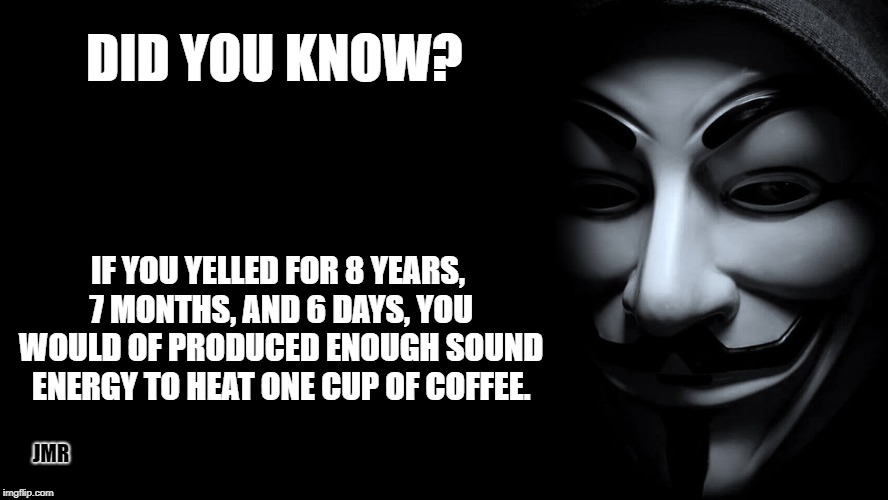If you yelled for 8 years 7 months and 6 days you would have produced enough sound energy to heat one cup of coffee

If you yelled for 8 years, 7 months and 6 days, you would have produced enough sound energy to heat one cup of coffee.

Have you ever wondered just how much energy sound produces? Well, according to an interesting fact, if you yelled for a period of 8 years, 7 months, and 6 days, you would have generated enough sound energy to heat up one cup of coffee. Sounds unbelievable, right? Let’s dive deeper into the science behind this fascinating concept.
To begin, it’s important to understand that sound is a form of energy that travels in waves through different mediums, such as air, water, or solid objects. These waves have the ability to transmit energy, and when sound waves interact with a material, they can cause it to vibrate.
Now, let’s break down the mathematics behind the claim. One cup of coffee typically contains around 237 milliliters of liquid. To heat this amount of coffee, we need to calculate the energy required. A standard cup of coffee has an approximate mass of 250 grams, and assuming an initial temperature of 20 degrees Celsius and a desired final temperature of 65 degrees Celsius, we can use the specific heat capacity of water to determine the energy needed.
Using the equation:
Q = m c ΔT
Where: Q represents the energy in joules, m represents the mass in grams, c represents the specific heat capacity of water (approximately 4.18 J/g°C), and ΔT represents the change in temperature (final temperature - initial temperature).
By substituting the values, we find:
Q = 250 g 4.18 J/g°C (65°C - 20°C) Q = 250 g 4.18 J/g°C 45°C Q ≈ 47,025 J
So, we need around 47,025 joules of energy to heat one cup of coffee.
Now, let’s focus on the sound energy generated from yelling. Intense yelling can reach approximately 90 decibels (dB) when measured at a 1-meter distance. It’s important to note that the intensity of sound decreases as distance increases due to the spreading of sound waves. Nonetheless, let’s consider this value for our calculations.
The equation to calculate sound energy is:
E = A d P
Where: E represents sound energy, A represents the area through which the sound passes (in square meters), d represents the distance over which the sound spreads (approximately 1 meter for this case), P represents the average sound pressure (in pascals).
Assuming an average sound pressure of 90 dB, we can convert it to pascals using the equation:
P = 20 * log10(P/P0)
Where: P0 represents the reference sound pressure (approximately 20 µPa).
After converting, we find that the average sound pressure is around 0.632 Pa.
Now, let’s calculate the area through which the sound energy spreads. Assuming a simple scenario where you are yelling in an open space, the sound waves will spread out in a spherical manner. The surface area of a sphere is given by the equation:
A = 4 π r²
Since the distance over which sound spreads is approximately 1 meter, the radius (r) will also be 1 meter. Substituting these values, we find:
A = 4 π 1² A ≈ 12.57 m²
Finally, we can determine the sound energy produced by multiplying the area, distance, and pressure:
E = 12.57 m² 1 m 0.632 Pa E ≈ 7.95 J
So, if you yell continuously for 8 years, 7 months, and 6 days, you would generate approximately 7.95 joules of sound energy, which is far less than the 47,025 joules required to heat a cup of coffee. Therefore, the aforementioned claim is not accurate.

It’s incredible how sound energy works, and though the claim may not hold true, the concept highlights the intriguing relationship between sound, energy, and everyday objects. While yelling might not heat your coffee, it’s still an interesting fact that showcases the magnitude of energy required to accomplish certain tasks. Next time you sip on a cup of coffee, take a moment to appreciate the fascinating world of physics that surrounds us.
Source: PhysicsCentral
Share
Related Posts
Quick Links
Legal Stuff

